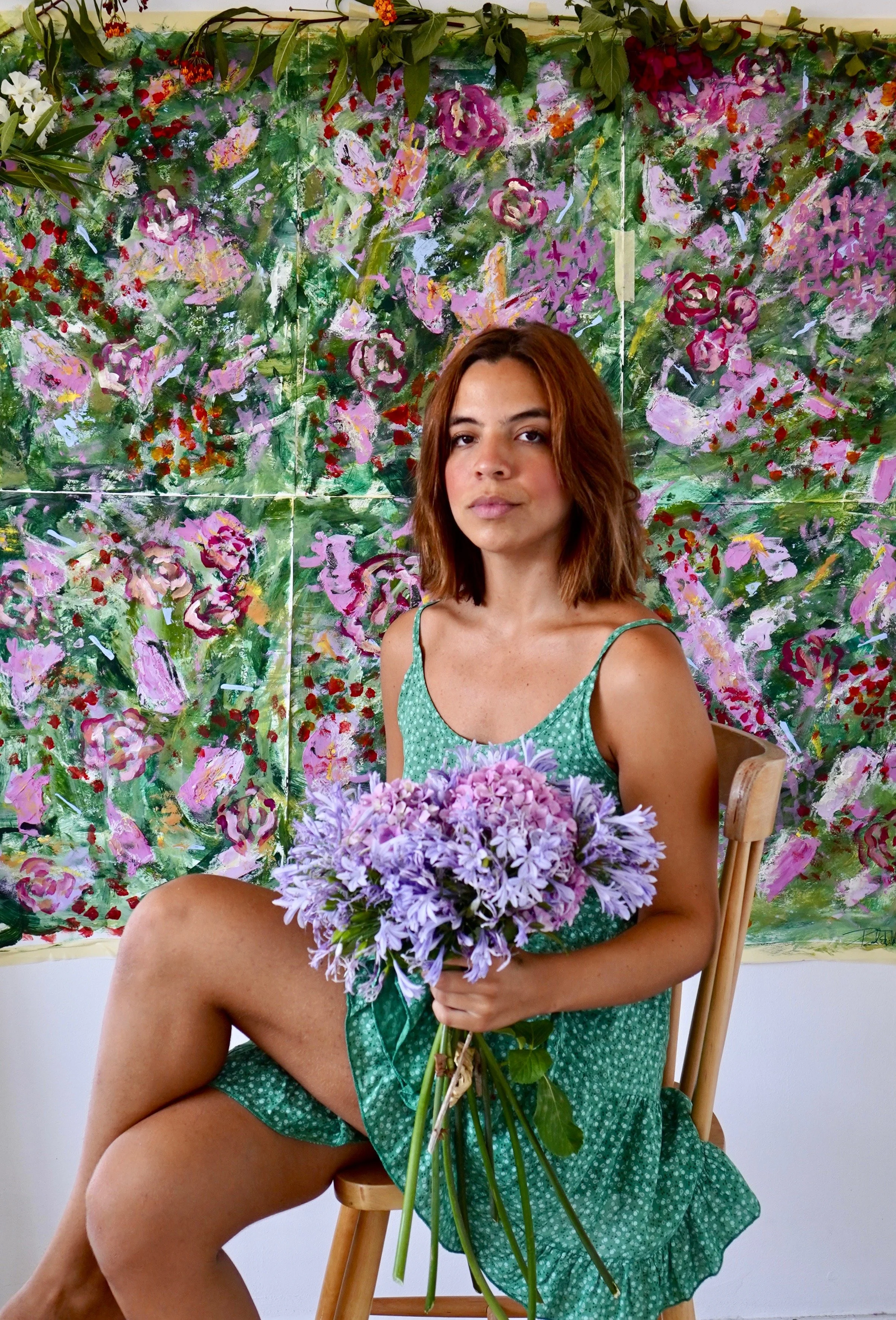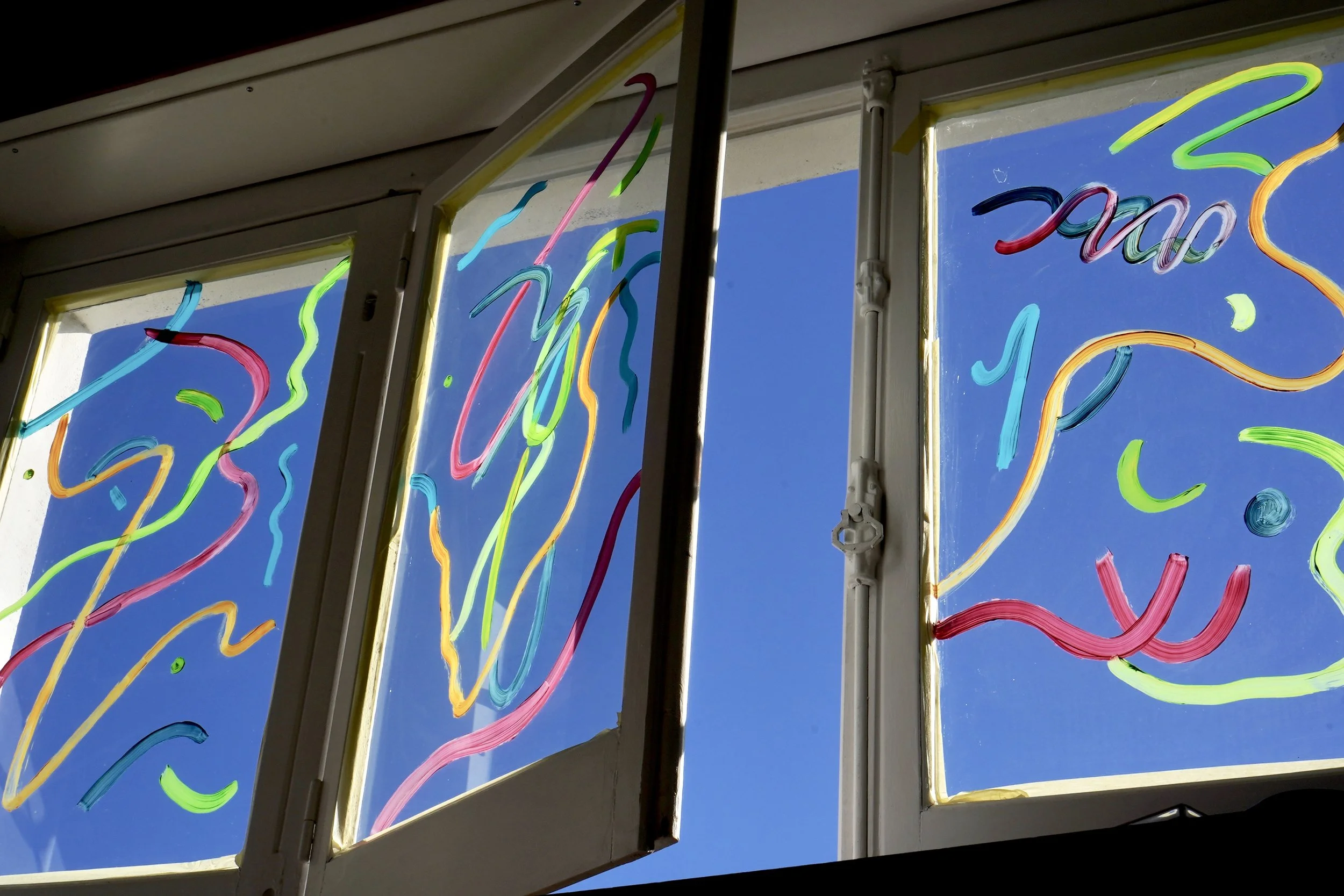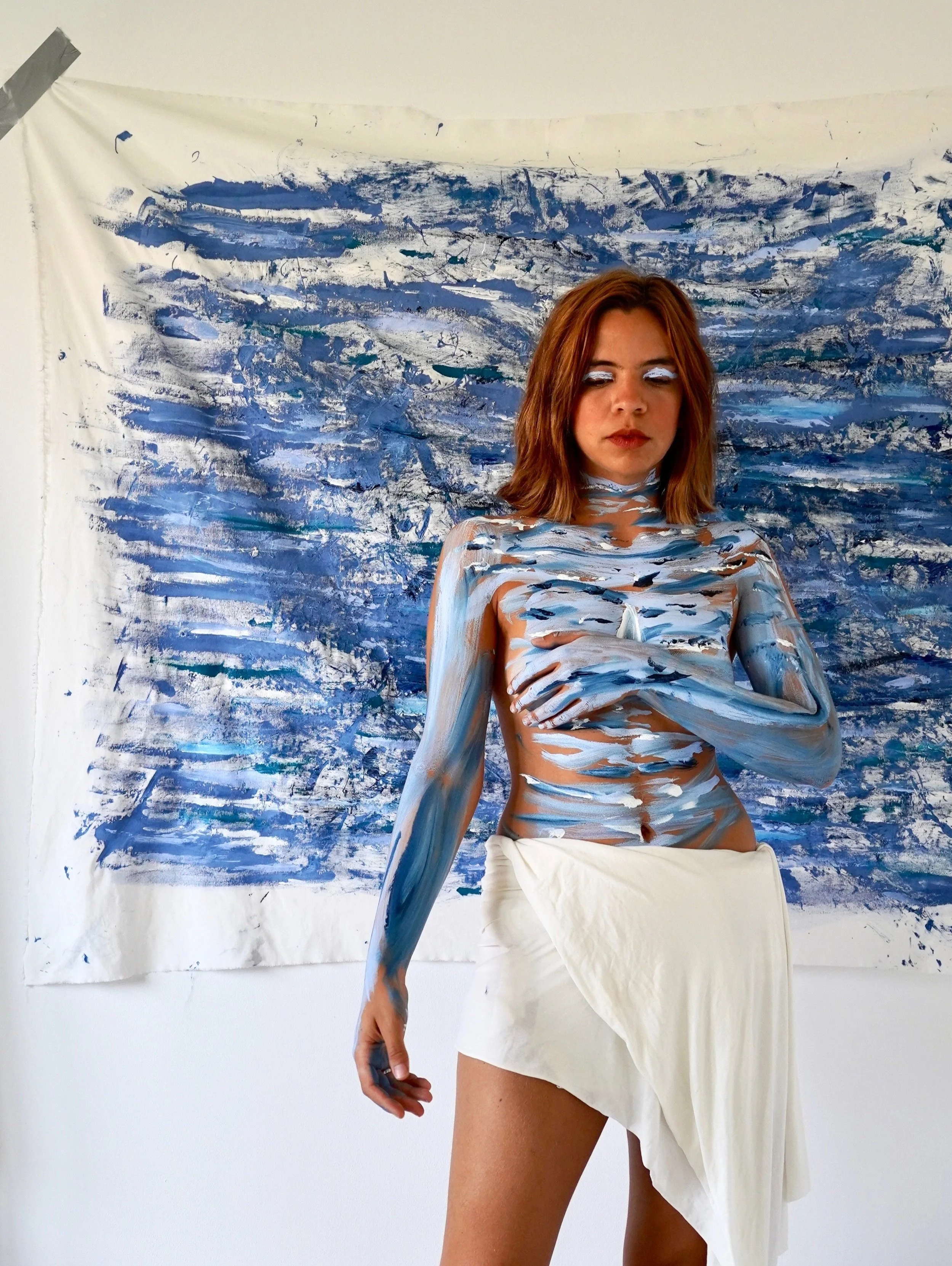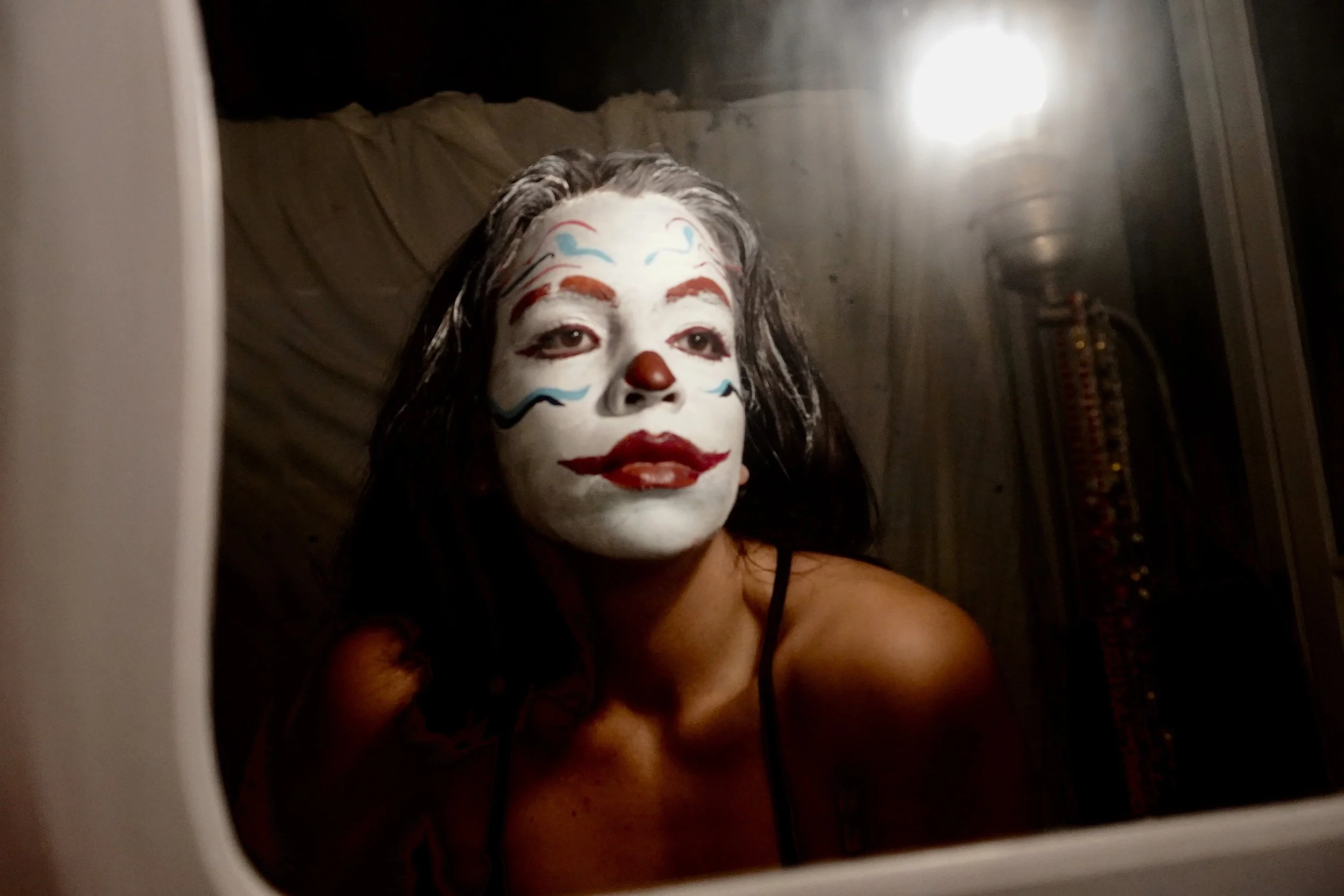10 Questions with Paola Fillippi
Paola Fillippi is a multimedia artist born in Colombia (1997), raised in Brazil and currently based between Spain and Portugal. While studying business management, Paola began exploring visual arts autonomously in 2019, focusing on photography and audiovisual productions. Her work reflects her personal pilgrimage towards individuation, expressing her feelings, dreams, and relationships through visual representations. She draws inspiration from Brazilian philosophical novels, Jungian analytical psychology studies, and spirituality concepts to build a language to communicate with viewers.
Through her art, Paola shares intimate human issues related to the inherent conditions of being in constant movement and detachment processes, reflecting what can be found in the spectrum of love and fear. Her work is often exhibited in intimate spaces that invite states of presence, silence, and connection with the observer's inner self. Paola has held eight solo exhibitions in Lisbon between 2021 and 2023 and has participated in three group exhibitions, two in Portugal and one in London.
Paola's artistic production encompasses writing, drawing, painting, and performance, all of which contribute to building the narrative and final image. Her current focus is on creating outsized works as a means of exploring human feelings and the stoic virtue of courage. In addition to her artistic production, Paola works with people to help them connect with their own creativity through artistic dynamics that have been part of her journey. She also helps people translate experiences, music, and memories into visual art forms.
Paola Fillippi - Portrait
ARTIST STATEMENT
Paola Fillippi is a visual poet and performance artist who embodies the role of a pilgrim walking towards individuation, a concept developed by psychologist Carl Jung. The process involves bringing the personal and collective unconscious into consciousness through means such as active imagination, free association, and dreams, which are further integrated with one's personality.
Therefore, using photography and video as her primary languages of expression, her creative process follows the same structure. By using these means, every form of visual materialization or performance is a result of self-observation of her personal unconscious and conscious experiences within the collective, followed by deep psychological analysis in order to create the final image and remember the path taken in the pilgrimage.
The aim is for the viewer to feel seen and connected with their human essence, discovering a new form of language that brings comfort to a part of themselves that was previously unexplored but conscious.
Happy Birthday To Me, Self Portrait, Digital File, 2021 © Paola Fillippi
INTERVIEW
First of all, introduce yourself to our readers. What is your artistic background and how did you start experimenting with images?
Hi readers, I'm Paola. I'm an independent multimedia visual artist and performer working on my career transition. In the meanwhile, going through a lot of internal and external readjustments that this process asks from a person.
About my artistic background, I attended business school and got into the labor market working with sustainable finance, so my practice and research were built autonomously and in parallel with this other path that I recently decided to leave behind. Actually, my decision was to take with me what resonates and leave what doesn't fit into this new phase, as an example, the idea of worthiness and success coming exclusively from corporate jobs.
Photography and video are my primary languages of expression, since they are a constant in my work and the type of media I first got in touch with. My experimentation specifically with images emerged from a place of necessity during the new year of 2018 to 2019. I went to the northeast of Brazil with my best friends for a road trip and the itinerary became extra special when I found out that my father did the same route when he was my age.
I found the whole thing poetic and didn't want to forget anything, so I started a journal, which didn't work well since Bahia is full of different stimuli, and there were just too many things to write about, and I wasn't able to keep up with the pace of it. I had the feeling and perception that all of my senses were being put to work and in order to really convey what was happening, I would have to use more resources besides writing my thoughts and experiences.
While I was there, it was easy to be completely immersed in the environment due to the typical music occupying the surroundings, the amazing typical food, the really nice weather, the saturated colors of the long beaches, and the warm wind. So to manage to capture everything, I started making videos, one per day, as a way of keeping my memories alive. After that, I started doing this on every trip that I wanted to keep a record.
When I came back home, moved by the mesmerizing sunset I was lucky to experience from my bedroom window, I decided to buy a proper camera and this was also another important step since I was able to experiment with many different areas of photography such as abstract, portrait, landscape and spend some time exploring each one. Since then, I have never stopped.
I Finally Got To Paint The Windows, Acrylic Paint on Glass, 2022 © Paola Fillippi
Why are you an artist, and when did you first become one?
Why? Because art became my way back to myself, my anchor, and it is the only consistent thing in my life. Since I left my country, I had my heart broken badly, got into complete chaos mode, and experienced grief and loss more times than I can count. Got in contact with my fears, anger, rage, and depression, lost myself for good, found myself again, screamed and sang in the car, traveled the whole country, felt completely empty and full at the same time, looked for help, searched for God, found him, found incredible generous people, lived in 12 different houses in less than 2 years, made some friends and had hard arguments with others which ended long relationships. Felt extremely lonely, called my parents asking for help, cried on the phone, laughed on the phone, got birthday calls, spent my birthday alone, experienced sexism and xenophobia, went back home, came back to Portugal, went to Spain chasing a dream, and had my dreams crushed. Tried again, found love in other places besides a romantic relationship, and discovered that I appreciate flowers and privacy is very important to me.
Well, and art? Art was with me this whole time. Out of all the parts of myself that I have been fighting against and also learning how to love during these years, sometimes paper and some paint bought in the closest supermarket was the only thing I had. I unconsciously was welcoming the need to create and gave it space to manifest whenever and however it wanted. And the other way around was also true, art has done the same for me. Like unconditional love, I noticed that art has the role of putting me face to face with my inner truths, which I must say are not always easy to swallow. At the same time, it has always been there for me, providing a safe space for dialogue and growth in order to become a better human being. I became an artist when I decided to actually commit and rebuild my existence around the most intimate and loving relationship I have ever had in my life.
You are originally from Brazil, but have lived and studied in Portugal as well. How did this move influence your work?
Everything. This move influenced me in such a way that today I'm on a real mission to unravel the mystery of my personal one million dollar question of "what happened over there" and what keeps happening. My work is deeply related to my personal life, it works like a mirror of the psychological process I am experiencing, and when I left my country I was also leaving this reality that, back in the days, was really controlling, suffocating and abusive. I was also living behind the part of me who was accepting that reality. So when I arrived in Portugal, where my environment was promoting freedom, I was obligated to adjust and start exploring this new way of being and occupying the space. After all, nobody there knew who Paola was, must say, not even me.
This enormous amount of freedom, lack of external control and inherent curiosity, led me to start traveling alone for long periods, putting me in contact with my solitude and what I was actually thinking about the world around me. It was traveling that I started to understand about self-responsibility and this was enough to bring to surface many other aspects of myself that I wasn't aware of. It was frightening and very painful to access parts of me that were completely unknown. It was during my first trip that I had my first breakdown, my "Jesus Christ what I am doing with my life" moment and the first time I felt the urge to paint. So I started incorporating this media into my work. Art, as a mirror and loyal friend, was making this move with me as well, exploring new territories while I was exploring new territories.Being in a country where art is really accessible, also contributed to big changes in my perspective. It was in May 2021 that I was able to see an exhibition of Louise Bourgeois at Serralves Museum in Porto city. Besides her spiders, the exhibition had her set of six paintings called "I Give Everything Away" (2010) that talked about a woman leaving her house. It was the first time I cried looking at art, the first time I felt seen by someone I didn't even know. "She gets it, she totally gets it" I was thinking in my head. And since then I understood what art can do to a person when it comes from a genuine place. And that is what I wanted to pursue with my work, to enable people to feel seen through art.
Gestação, Photography of Acrylic Paint on Skin, Digital File, 2022 © Paola Fillippi
Wanted So Much Lighness That I cover Myself With It, Self Portrait, Digital File, 2022 © Paola Fillippi
You define yourself as a visual poet. Can you tell us what this means to you?
The visual poetry aspect came from a place of trying to find common ground that connected all my work. At the same time, poetry, as we know, was something that became present in my work since I went to Portugal. The use of words to build context and even help me understand my own work is something very present in my process, which can be seen in some titles, descriptions, texts, and speeches. Because of this analysis, I considered my work to be visual poetry. But today, I can understand that my work is still in transformation and gaining shape, so the definition may go through some changes as well. I have been a photographer and video maker, a multimedia artist, a visual poet, a performer, and now a pilgrim. In this search of finding common ground and bringing language to work is how I have been finding other interesting definitions that fit best accordingly with the moment my work is at.
Can you tell us about the process of creating your work? How do you go from the first idea to the final outcome?
In terms of the process, my work consists in bringing personal unconscious manifestations to consciousness through art and then analyzing it. The first part is probably the one that has the most structure, which is mainly done by keeping track of my thoughts, dreams, and actions in a diary. I do this exercise every day when I wake up. But also I keep the diary next to me in case I want to add something during the day. Bringing the work to life then is a very intuitive process, and it is something that I can see happens spontaneously. The amount of movement, traveling, and house swaps during the last years taught me that art is not something detached from my reality and that I could do art with pretty much anything. So in terms of materials, I have the mediums which I am more familiar with, but I also give space to exploration when I have nothing more than my own body and my phone. Also, time is very important in the equation. Rather than dedicating long periods to a specific painting or creation, I construct my work in layers over time. In the meanwhile, I dedicate some time to research the specific topic I'm working on: reading Brazilian psychological novels, researching human development, talking to people, and, eventually, with myself on the pages during the morning. Once I have nothing else to add to the story and have found my answers through research and experience, the work is finished and presented to the world, where it resonates with other processes or takes on new meanings.
What themes do you pursue with your work?
The context of my work is the journey of a now 25-year-old white Brazilian woman who had several traumatizing episodes during her childhood and adolescence, had difficult experiences with her parents while growing up, and at some point was fed up enough of being a victim and decided to be the person making her own life decisions. And that involved moving away from her country and looking for answers to her non-exhaustive list of philosophical and human behavior questions. My artwork and consequently pursued themes are deeply intertwined with this story and all the psychological processes that happened and are still happening during the journey.
Since I've completed the Saint James walk, a long spiritual hike towards Santiago de Compostela, I could make the parallel of being a pilgrim in my own life and artwork. In this sense, instead of going to Santiago, I'm actively moving towards what the psychiatrist Carl Jung puts as individuation, a lifelong process of integration of psyche aspects (repressed memories, emotions, instincts, archetypes, and universal symbols) to achieve a sense of wholeness and completeness. So my themes consist of everything surrounding this exploration. As an example, I have works that talk about my inner child relationship, others that talk about my recently improved relationship with my parents, works that are deeply intertwined with my fears and hassles, and works that talk about ugliness, and love. So I can say, they are themes surrounding the human experience and our relationships with ourselves and with others.
The Great Clown I am, Self Portrait, Digital File, 2022 © Paola Fillippi
What's the essential element in your art?
Presence.
How do you promote your work? And how do you keep your followers engaged?
Initially, social media was an effective tool for selling my photography in Brazil, where the people are known for being heavy internet users with high engagement. As I began sharing my work and building authority in the field, I generated sales through Instagram stories and print-on-demand services. However, after moving to Portugal, I noticed a shift in buying patterns. Firstly, my social media engagement decreased as the majority of my audience was from Brazil. Secondly, I understood that Europeans have a different relationship with the internet and also with art. Since Lisbon had many physical spaces dedicated to exhibitions and loads of opportunities, this led me to explore the idea of taking my work offline and offering in-person experiences. That's how I started making my own exhibitions, initially in non-conventional spaces like stores, warehouses, and even abandoned hostels, which not only helped me understand the fair price of my work but also taught me more about my buyer persona. As a result, my promotional strategy today combines working to be positioned correctly in digital space but also running tests on the physical world in order to see what works, allowing me to capitalize on opportunities in both realms.
Solitude, Photography, Digital File, 2021 © Paola Fillippi
What do you think about the art community? Do you feel you have found your place there?
Up until the middle of last year, I often felt lonely and isolated, especially as I lacked close role models or peers to look up to during a time of transition. This made me feel disconnected from the bigger picture, and I began to wonder if something was wrong with me. However, this experience also provided me with the internal space to process the complex emotions and challenges that came with walking this path alone. Nevertheless, the solitude eventually grew tiresome, and I felt fortunate to discover a community during an artist residency last May. There, I met other artists - singers, dancers, musicians, and a photographer - who understood my experiences and could relate to my journey. Within this community, I felt a sense of belonging and began to create alongside others. In fact, I became part of the community and formed close relationships with some members while feeling mutual affection and respect for one another. So yes, I can say I started to find my place.
Finally, any projects you are looking forward to for this year?
This year, I am focused on pursuing projects that align with my purpose of promoting transformation through art. Some of these projects are collective, like performing among other artists in festivals, working with children striving for their creative development, and collaborating with other art initiatives. On the other side, I'm working on my own projects where I combine the best tools of my own experience with creativity development in order to pass on this knowledge in the form of workshops, individual mentoring, and group development cycles facilitated by me. As I engage in this work, I am moving beyond creating art solely within the confines of my own room and becoming more actively involved in the world around me. By taking this step, I believe I will be better able to connect with others and make a positive impact through my work. In the end, it is really all I want to do.






















